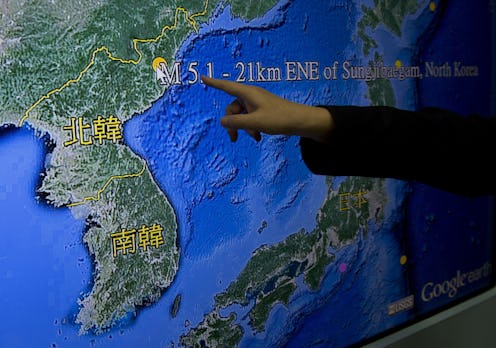News
This Is What A Hydrogen Bomb’s Blast Radius Would Look Like

Following the apocalyptic address President Trump delivered at the United Nations on Tuesday, North Korea's Supreme Leader Kim Jong Un has lashed out. Plenty of name-calling has ensued, including terms like "rocket man" and "dotard," which Merriam-Webster defines as someone in a state of senile decay. North Korea has also threatened to test another hydrogen bomb over the Pacific Ocean, a warning that has put neighboring countries on alert. But what is a hydrogen bomb's blast radius, and would nearby nations in the Pacific feel it?
The foreign minister of North Korea, Ri Yong Ho, told reporters in New York that this would probably mean the country's strongest hydrogen bomb test over the Pacific. Ri said he did not know what exact measures Pyongyang would take, as Kim is the ultimate decision-maker. It's unclear how wide the North Korean hydrogen bomb's blast radius would stretch, but an online tool can calculate possible outcomes. North Korea's past nuclear tests also indicate the country has been improving the range of its missiles and strength of its bombs.
Following North Korea's successful launch of an intercontinental ballistic missile in June, the country conducted its most powerful nuclear test to date on Sept. 3, and it set off a magnitude 6.3 earthquake near the nuclear test site of Punggye-ri. North Korean officials claimed September's hydrogen bomb yielded an estimated 100 kilotons of energy. For comparison, the bomb the United States dropped on Nagasaki, Japan yielded 20 to 22 kilotons of energy.
Online tool NUKEMAP, hosted by the Stevens Institute of Technology, lets people calculate the blast radii, estimated fatalities, and fallout contours of a hydrogen bomb explosion based on the data you input. Fallout contours refers to radioactive material a hydrogen bomb propels into the atmosphere that then falls out of the sky. By entering a 100-kiloton yield and moving the location marker to a spot in the Pacific Ocean, NUKEMAP estimates zero human casualties. It also calculates a fireball radius — the innermost circle to ground zero, hotter than the sun and kills everyone — of 500 meters and a thermal radiation radius — capable of third-degree burns — of up to almost 4 kilometers (2.5 miles). With wind at 15 mph, radioactive fallout could cover a maximum distance of about 126 miles.
So no, a hydrogen bomb fired to the middle of the Pacific Ocean won't immediately kill any humans. Still, a hydrogen bomb harms the environment. A nuclear blast could kill or poison marine life, possibly disturbing the local ecosystem. Earthquakes, whether natural or manmade, are capable of sending shockwaves deep through the earth. In French Polynesia, nuclear tests caused environmental disasters such as landslides, tsunamis, and earthquakes.
The effects on humans might not be immediate, but can show up over time. People living near other nuclear test sites, such as Bikini Atoll in the U.S. Marshall Islands, are still dealing with the harmful effects of radiation on their health, including cancer, birth defects, and thyroid disorders. Leaders in South Korea and Japan are on alert, should the North Korean military mount a hydrogen bomb on a medium-range or intercontinental ballistic missile that could fly over their respective countries. Japan must brace itself for nuclear impact if North Korea carries out its threat, warned Japan's defense minister Itsunori Onodera.
The U.S. military already operates under the assumption that North Korea has the capability of launching a missile that can reach as far as U.S. territory Guam, which has a population of more than 162,000 people and hosts a strategic military base. But for now, we'll have to wait and see. Jeffrey Lewis, an expert on the nonproliferation of nuclear weapons in East Asia, told CNN that we won't know for certain what North Korea is capable of until they do it.